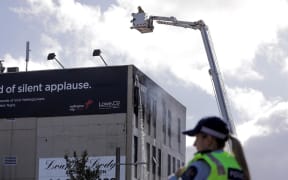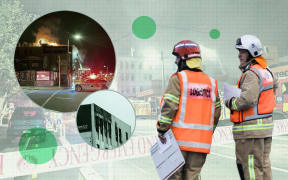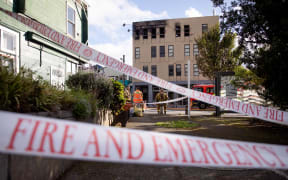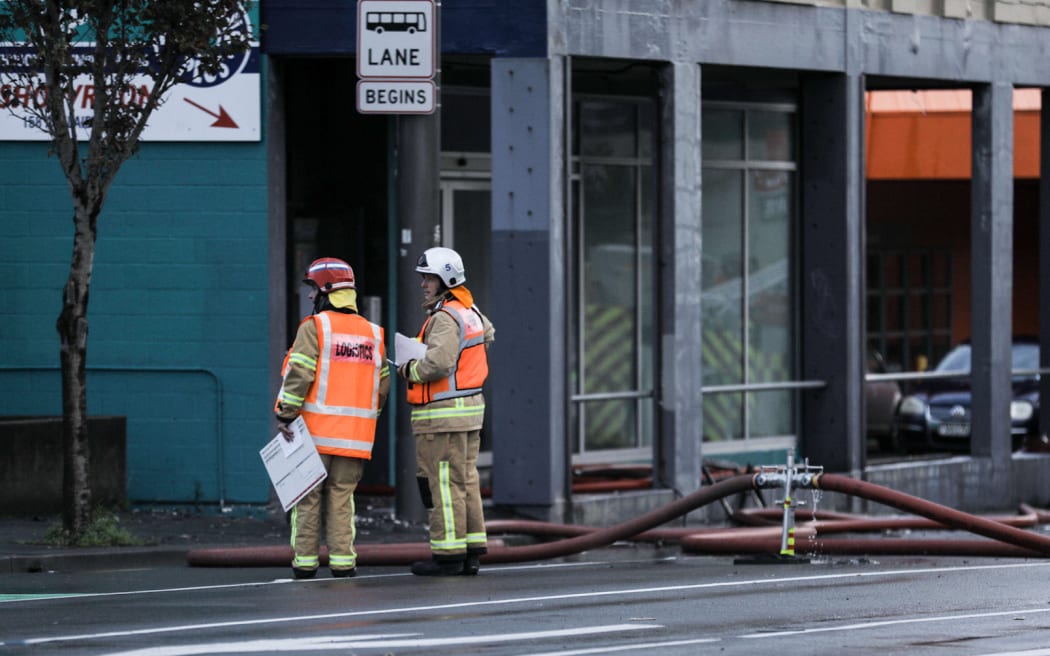
Photo: RNZ / Samuel Rillstone
Investigations are underway into what went wrong in evacuating Wellington's Loafers Lodge last night.
The 92-room, short-term accommodation block had fire alarms, a smoke extraction system and two stairwells to get out, but did not have sprinklers.
"There's not a requirement for sprinklers but it would have been a good idea," said Charlie Loughnan, a Christchurch fire protection specialist of 25 years and ex-firefighter.
"But sprinklers are expensive so people don't tend to put them in unless they have to."
A 13-part, four-page compliance schedule for a Building Warrant of Fitness (BWOF) at Loafers Lodge shows it had a type three fire alarm.
This alarm was triggered by heat, typically at 57 degrees Celsius, Loughnan said.
"That means if you stuff a waste paper basket full of newspaper and set it alight in the corner of the room it would be going really well by the time the system activates.
"You are on fire and the clock is ticking fast."
However, the BWOF also showed supplementary smoke alarms in the corridors and separate alarms in the bedrooms.
"I would guess this system was installed between 1998 and 2004, so is pretty old but should function OK," Loughnan said.
Fresh from a briefing by officials earlier today, Housing Minister Megan Wood said the safety requirements "were all being met" at Loafers Lodge.
No concerns were raised when the building was checked by an independent expert just two months ago, she said.
A Pentecostal church used to be run out of the Loafers building, which was called the Lifepoint Building in the 1990s. It also housed Westpac bank's Newtown branch.
Its first building warrant of fitness as Loafers Lodge was issued in February 2010, and most recently renewed on 2 March this year - by which stage it had been expired for a week - according to Wellington City Council records.
The change of use around this time - apparently from a church to a lodge, though that has so far not been confirmed by council records - was required to be notified to the Wellington City Council.
Loughnan said the capital was unusual in the number of old buildings turned into accommodation.
Sometimes when a change of use was sought, checks were run by Fire and Emergency.
Internal Affairs Minister Barbara Edmonds said she was not aware FENZ had ever inspected the building in Adelaide Rd.
"As far as I know, I haven't been advised so."
Loughnan said the fire appeared to have spread rapidly and believed it got into a "safe path" and prevented people from being able to escape.
"Safe paths" include stairwells, which the rules say should be painted with non-combustible paint.
The BWOF attests to annual checks undertaken by an IQP, or Independent Qualified Person, of the 13 safety systems - out of a possible 16 - which the 1970s, five-to-six-level Loafers block had.
The checks on its alarm system and smoke-doors, were by Aquaheat, which signed systems off as "fully complied". Another firm, Argest, signed off on fire separations.
Buildings under 25m with two stairwells, even residential ones, do not require sprinkler systems. With one stairwell, the height limit is 10m tall.
Loafers' mechanical smoke control would be designed to kick in when smoke was detected, but depended on the fire alarm working, Loughnan said.
The BWOF shows fire doors had 'hold-open' magnets on them that let doors close and seal when there was an alarm.
One of the risers for firefighting water had a leak in it.
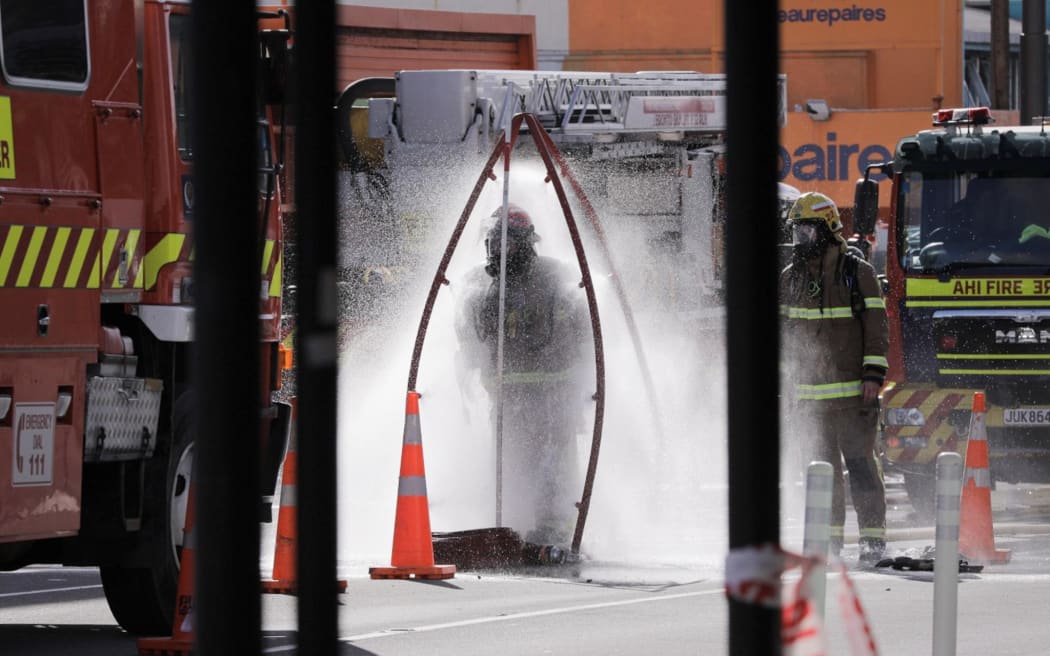
Photo: RNZ / Angus Dreaver
The country's building warrant of fitness system has been both praised and questioned by fire industry professionals.
A lot depends on the qualifications and experience of the IQP who does the annual checks, and since there are up to 16 systems, IQPs often specialise.
Loughnan said he was an IQP for sprinklers, but "not an expert in every facet ... I've gotta go see my engineering crew".
Councils vet the IQPs, and the Ministry of Business, Innovation and Employment audits the council's warrants systems.
In 2018 the ministry said it would be reducing the audits, even though it was aware of gaps in the system.
The system also relies on building managers doing monthly checks on the fire doors and stairwells.
Loughnan noted how short-term accommodation typically lacked storage, so people sometimes put bicycles or other gear in stairwells and corridors, a no-no for speedy evacuation.
Asbestos
Loafers Lodge had some roofing with asbestos in it, and small pieces of it had been scattered about, the council said.
"Asbestos fibres are not considered a health risk unless they are present in the air," the council said.
The firefighters' union has previously challenged the adequacy of FENZ's handling of asbestos at emergencies, but FENZ has defended it.
In a series of RNZ OIA responses and statements last year, FENZ said fire crews were sometimes advised if a site had asbestos at it when they were on their way to a fire.
An OIA showed that FENZ had a total of 8940 such site reports on buildings across the country, and 521 of these mentioned asbestos.
A fire engineer who has studied boarding house risks, Dr Geoff Thomas, said the safety rules for multi-unit blocks needed better enforcement.
His research a few years ago found such buildings, if they did not have sprinklers, had the highest fire casualty rates.
"The rate of fire fatalities was about twice that for residential houses, but if it was unsprinklered it was four times that."
Thomas noted that whereas crowded or high-risk buildings like shopping malls, office blocks and hospitals had high hazards, they also had lots of protections, like mandatory sprinklers.
By contrast, short-term accommodation was a weak spot, he said.
This was made worse by the fact that people were most commonly alerted to fire by the smell (where alarms did not sound), and when people were asleep and had no sense of smell, Thomas said.
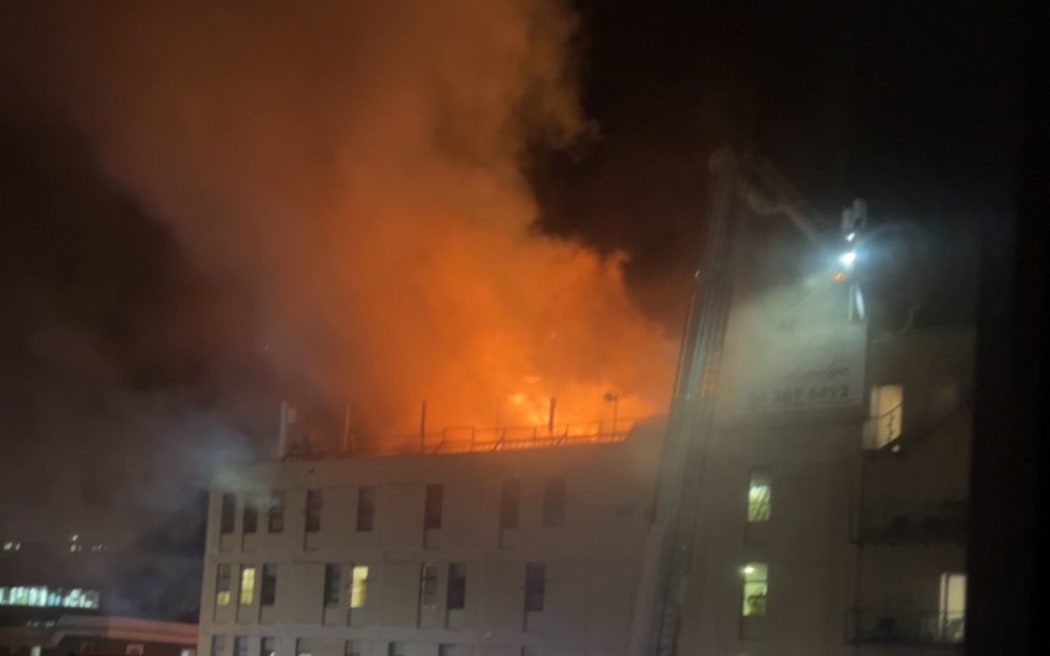
Flames and smoke billow from the Loafers Lodge in Adelaide Road, Newtown, on Tuesday morning. Photo: Supplied / Katelyn Paul
'All that human tragedy wouldn't be here'
FENZ deputy national commander Brendon Nally said if the building had fully working sprinklers "then the result would be way less than what we're dealing with now, I'll tell you that straight up".
"My firefighters, the great comms team operators, wouldn't have had to go through the tragedy, We wouldn't have had people that are deceased, we wouldn't have families that are missing loved ones, we wouldn't have people worried that they can't find people.
"All that tragedy, all that human tragedy, wouldn't be here if this building was fully sprinkled with an operable system."
Fire Protection Association's Chris Mak told Checkpoint he would not personally stay in a hotel of this type unless it had a sprinkler system.
"If there is an uncontrolled fire and people are not warned of the fire an evacuate early enough, unfortunately what happened today, would happen."
The rules were always evolving and changing, he said.
"The rules today are fit for purpose. When this building was built, they may not have been fit for purpose."

